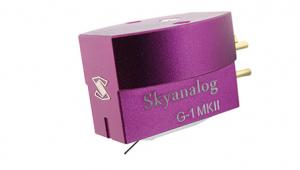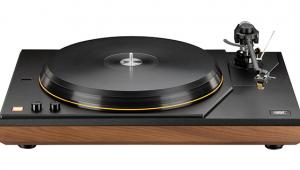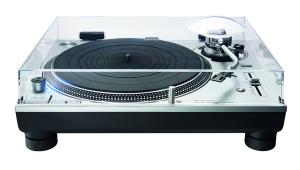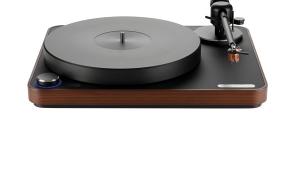Pro Ject V Pack (£1000)
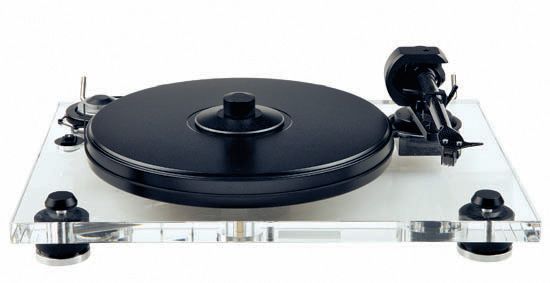
There’s always been a strand of hi-fi culture that says you have to suffer to be beautiful, an idea that you just have to go through a lot of mixing and matching, and twiddling and tweaking, to get good sound from the old vinyl LP. If you’re prey to this kind of thinking, an all-in-one, plug-and-play record deck solution just seems too easy. But why fight it, when the manufacturer will do it all for you?
Pragmatic as ever, Pro-Ject offers a huge range of package options, from its basic Debut series upwards. If you’re just trying to stop your spending going much into four figures, you can try a package in the more refined Xperience series.
Pro-Ject’s ebullient founder Heinz Lichtenegger spent a lot of time in the early days of the company experimenting with different materials, finding for example that when he made a turntable entirely out of MDF, it sounded coloured but it ‘grooved like crazy’.
DIFFERENT OPTIONS
So Pro-Ject’s more recent designs have tended to include cunning combinations of materials in pursuit of particular subjective sonic ‘flavours’. With the 2-Xperience turntable concept, Pro-Ject offers a choice of plinth material, the Classic in MDF (finished in mahogany, olive or piano lacquer) and the rather zingier-looking (and perhaps zingier-sounding) Acryl in clear acrylic. As for the package options, the lowest-cost complete player is the £775 2-Xperience 2-Pack, which comes with an Ortofon 2M Blue MM cartridge installed.
More luxurious is the 2-Xperience X-Pack, at £1050, with Ortofon Rondo Blue MC cartridge and electronic switching for 33.3/45rpm speeds. But now there is a third option, the 2-Xperience V-Pack reviewed here. With this new V-Pack, priced at bang-on £1000, Pro-Ject gives you a newly introduced Ortofon MC, called the Vivo Blue. Bought separately, this would cost you around £100 less than a Rondo Blue. On the other hand, the V-Pack gives you a higher-grade tonearm than does the X-Pack.
Simple enough at first glance, the turntable plinth is just a nice chunky 20mm-thick piece of acrylic. But all the parts bolted on to this have been carefully developed in terms of design and material selection. To start with, there’s what Pro-Ject calls its sandwich platter, an MDF core faced on top with a 5mm layer of vinyl. This matt-finished vinyl playing surface includes a slight recess at the centre to clear the label area, so even with discs where the label or a surrounding ridge stands proud, the underside of the disc should still make good contact with the vinyl platter surface right across the playing area.
A light and well-designed clamp is provided, which slips easily over the centre spindle and tightens on its quick thread with little more than a flick of the wrist. Even if, like me, you hate the fiddle of record clamps, you’ll find this one is very easy to use.
Underneath, the platter’s integral ground steel shaft fits into a conventional main bearing. A thrust pad under the radiused end of the shaft supports the platter’s weight while the shaft itself runs in a precision journal. On the review sample there was perceptible play, though, as it was possible to rock the platter slightly.
MANUAL CHANGE
To get the record spinning, there is a low-voltage synchronous motor, which receives 16V AC from a small plug-top power supply unit at the other end of a conveniently 1.8m-long lead. Drive is via a long square-section belt, and the motor is compliantly mounted on rubber, in a smart modern Teutonic execution that’s nonetheless the same in essence as the homely Connoisseur mounting of 40 years ago, which used ordinary elastic bands. There is an on-off switch, but if you want to change speed from 33.3 to 45rpm, you have to lift the belt manually on to the smaller of the motor’s two pulley diameters. A plastic hook is provided so that you can do this conveniently without fingering the belt.
If you play 45 records a lot, you want to consider the alternative 2-Xperience X-Pack, because this includes Pro-Ject’s Speedbox electronic power supply to give speed change at the touch of a switch.
However, the V-Pack gives you the benefit of the 9cc Evolution arm, designed for greater rigidity with its beefier bearing yoke piece. This carries Pro-Ject’s usual thread-and-weight for bias compensation. Although the coned carbon-fibre tube and headshell are made in one piece, there is a joint at the back end of the arm, and by loosening a retaining screw the tube can be released and rotated slightly to correct the azimuth alignment. This could be useful if you find that your cantilever is not in fact in line with the vertical axis of the cartridge.
At the back, the counterweight is Pro-Ject’s usual type, filled with damping material and fitted with a loose calibrated ring to set tracking force. You screw the weight along the shaft, set the scale to zero and then wind it forward without touching the ring to apply the desired tracking force, in this case 1.8 to 2g. Signal connection is via detachable phono interconnects, giving scope for upgrading.
RELEVANT POSITIONING
So, with very little set-up time, I got down to listening, starting with Jennifer Warnes and ‘Ballad Of The Runaway Horse’ from Rob Wasserman’s Duets [GRP 97 121]. At the bottom end, Wasserman’s bass managed to sound substantial without becoming too boomy. Jennifer Warnes’ voice was quite well characterised, with a good feeling of placement, and a pleasant enough overall midrange, although I couldn’t completely get rid of a very slight shouty or peaky quality.
At the top end there was a feeling of reasonably good detail in a smooth and yet quite lively treble. True, you didn’t get that ultimate feeling of intimacy where you can almost see the studio walls, but the overall quality and impact of the performance still made it enjoyable to listen to.
I’d begun using the deck without its cover, but now I tried putting this on. With the lid in place, and the deck fairly close to the speakers, the sound lost a little of its ease and naturalness and, at anything above small-hours suburban listening levels, it could gave a slightly congested or blaring effect on the peaks in Warnes’ vocals. Similarly, the bass sound became rather uneven and overblown, Wasserman’s acoustic double-bass losing a lot of the subtlety that makes it pleasing to the ear, and tending to sound more like a big, rather indistinct ‘whoomph’.
I should say that I’d already tried locating the turntable well away from the speakers on a solid foundation, and this produced a much more relaxed and ultimately satisfying sound. Experimenting with turntable supports and positioning, I even tried placing it on a solid floor outside the listening room, and found, predictably perhaps, that this gave a much better ‘breathing’ quality to the bass, and in fact the whole sound.
With Dire Straits and ‘Sultans Of Swing’ [Vertigo 9102 021] the Pro-Ject gave a robust, convincing performance, Knopfler’s vocal sitting fairly comfortably in front of the nest of guitar sounds. In the end, the overall balance was little too forward for my taste, and not quite managing the open, relaxed quality that this track can take on with higher-grade MCs.
Moving on to Clapton’s 461 Ocean Boulevard [RSO 2479 118] the Pro-Ject really got going on the great slide guitar workout of ‘Motherless Children’. Here the Pro-Ject gave the music a great beat and seemed to revel in flinging those wild guitar sounds from speaker to speaker. ‘Give Me Strength’, the contrasting track that follows, had a really solid feel to it too. In fact, it was if the Pro-Ject was right at home with this material, giving a gutsy rock ’n’ roll feel without descending into grunge.
COME IN FROM THE COLD
With an old classical favourite, Barenboim’s 1967 recording of the Mozart Piano Concerto 21 with the English Chamber Orchestra [EMI ASD 2465], I felt that the Pro-Ject V-Pack’s outgoing personality did bring a quite strikingly dramatic quality to the music, even if, once again, this was at the expense of some subtlety.
On the brightly recorded strings, the Pro-Ject could sound quite brusque but never went over the edge into harshness. On Barenboim’s piano entries, it sounded lucid enough, but once the whole orchestra was involved it could only do a moderate job in revealing the details and timbral subtleties that make up the whole picture.
On the direct-cut King James Version [Sheffield Lab LAB 3] the Pro-Ject sounded quick and light enough on its feet to put over the swing feel of the Harry James band on ‘Corner Pocket’. The bass was sufficiently clean to give a good bouncing beat, although it could have done with a bit more clarity or definition. There was a good sense of space too, with the band’s layout clearly audible and making sense. James’s first trumpet solo came over well, while the brass section work sounded smart and snappy. Les DeMerle’s drums were powerful and effective.
With Oscar Peterson’s trio in Action [MPS 68.073] again the Pro-Ject did well at conveying the life and energy in the music, the piano sound full and dynamic. Although of course it is Peterson’s joyous virtuosity that bursts out at you, listening to this disc is to find yourself being constantly arrested by the amazing rapport and interplay with bassist Ray Brown and drummer Ed Thigpen. This music is surely a kind of perfection in its genre, and the Pro-Ject lets you appreciate it.
Finally, on a great old live recording, Albert King’s Live Wire/Blues Power [Stax SXATS 1002] from 1968, with King’s magnificent guitar. Here the Pro-Ject really did bring the music and the occasion to life. It fully conveyed King’s communication with his audience in the talking-blues title track, and allowed his magnificent guitar sound to soar. You could find points of criticism from a coldly hi-fi point of view, you could perhaps ask for even better control in the bass, a bit more detail in the top end, an even bigger space in the soundstage.
But none of that mattered too much, because it was still the sort of sound that made you want to run out and drag other people in to enjoy it.
VERDICT
Around this price, Thorens’ TD309 can sound more lucid if less full-bodied, but comes with only a basic cartridge and no lid. There’s competition from Clearaudio, but the V-Pack scores thanks to the likeable new Ortofon Vivo Blue cartridge. So it’s the best of both worlds, a package that sounds fine out of the box, even with non-ideal placement, but will respond to tweaking. It gets a warm recommendation.
Originally published in the May 2011 issue








